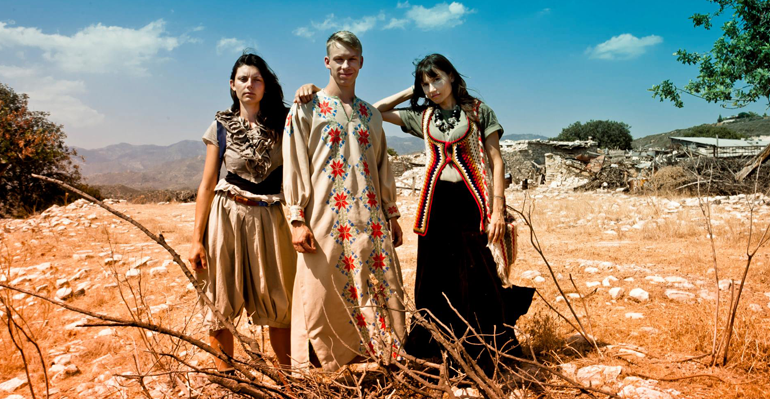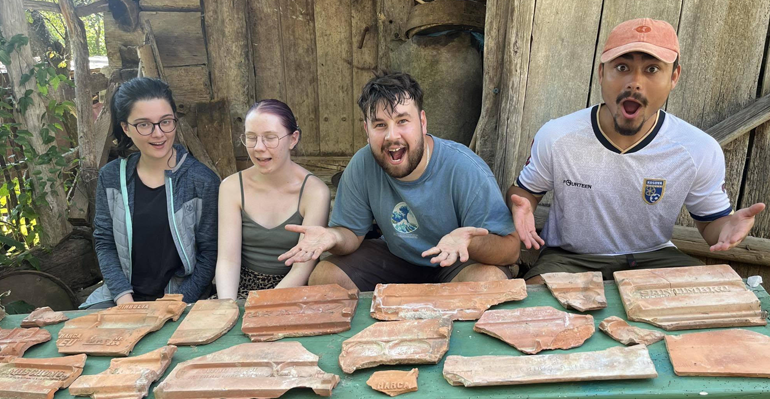
Mosaic as part of Cypriot patrimony, Hellenistic, Roman, Medieval and into the modern era
Introduction:
Cyprus is blessed with some of the best “Classical Period” (Ancient Greek through to Byzantine) mosaics in the world. Visitors are able to trace the development from simple arrangements of flat black and white pebbles, through stone ‘tesserae’ to purpose made and brightly coloured glass. The reason the ancient mosaics are so intact, is geological. Cyprus suffered terrible earthquakes, some of the most devastating occurring in the 4th century AD, particularly in 332 and 342 AD, which led to the destruction of ancient cities like Salamis and Paphos. Whole cities were flattened, and the survivors just walked away and built elsewhere. Partly due to the fantastic archaeological legacy, contemporary mosaic has flourished, with Limassol’s ‘Mosaic Collective’ becoming well known. Also because mosaic making is such an important part of Cypriot patrimony, the state has trained many new practitioners and that’s where Kato Drys Community Council and partners come in.
This ‘Mosaic Heritage Trail’ in Larnaca, Limassol and Paphos district’s coastal region, is offered by Kato Drys Community Council and their stakeholders, Mola Culture Factory. It links to opportunities to learn the art of mosaic making. The trail includes the following visits and activities:
- The Old Olive Mill, Pano Lefkara and modern mosaics in Pano Lefkara and Kato Drys (Day 1).
- The ruined Roman city of Kourion near Limassol (Day 2).
- The temple of Aphrodite in Kouklia near Paphos airport (Day 3).
- Paphos Archaeological Park, UNESCO World Heritage site (Day 4).
- Return to Pano Lefkara for a day of mosaic training (Day 5), with an option of a second day.
Find the link to the map of the trail below, or contact the Mola Culture Factory for more details.
What you'll discover:
- How the art and craft of mosaic has developed over the ages from simple pebbles to tesserae to modern materials.
- The purpose behind mosaics – hidden messages.
- Cypriot mosaics – the link to lace making.
- Mosaic as a way to draw attention to environmental issues.
- The creativity that lies within you through an optional training course.
The Old Olive Mill – Mola Culture Factory, Pano Lefkara
The Old Olive Mill – Mola Culture Factory is an outreach centre for Kato Drys Community Council. It is where induction and orientation occur. If participants do add-on skills training, this is the venue. The Mill has many mosaics using a variety of media.
Kato Drys Vintage Emporium
At this stop you will tour local mosaics in Kato Drys and see some made from a variety of waste materials.
The ruined Roman city of Kourion, near Limassol
At stop 2, you’ll see Roman and Byzantine mosaic and witness how themes and focus changes. If time allows, you can also visit to shops in Limassol to see mosaic making supplies.
The Temple of Aphrodite at Kouklia, Paphos District
Stop three is in about 1.5-hour drive from Pana Lefkara or Kato Drys. At this stop, you’ll visit the Temple of Aphrodite at Kouklia. In the Medieval Venetian villa there, a Roman mosaic floor is preserved and it is a good place to discuss the link to Cypriot lace patterns. There is also a fine example in mosaic of the Classical theme ‘Leda and the Swan’- it is a remarkable Roman period original.
The Paphos Archaeological Park
On the same day trip, you visit the Paphos Archaeological Park to see the UNESCO protected mosaics that are Hellenistic, through early and late Roman periods. We will talk about symbolism in mosaics and touch on the issues of protecting them.
Why this trail matters:
- The story and the experience will help to stimulate the local economy in a sustainable way
- Visitors will learn more about the local cultural landscape that few tourists see.
- Discovery by tourists, from Cyprus and abroad, will raise awareness of the need for recognition and protection of patrimony, as it applies to the traditional skill of mosaic making.
Although many themes of mosaics are religious, the art/craft itself is secular and useful to bring people together in a creative and open way through social mediation.
Heritage Trail Map:
Heritage Trail Details:
- Length (km):
- About 132 km
- How it could be undertaken:
- Driving
- Special notes (clothes, equipment, weather, etc.):
- Between the end of October and the end of March, rain is possible and a light raincoat is needed plus a warmer jumper of fleece. At all times wear a hat, even in winter the sun can burn and in Spring, Summer and Autumn, sunburn is commonplace. You should also wear sun cream of over factor 40, especially if not between end of October and end of March. If walking you need strong shoes with good ankle protection. Do not walk into the ‘maquis’; it is prickly and unyielding.
- Safety guidelines:
- Follow the rules about clothing and staying on the track. Cyprus has a few quite dangerous examples of wildlife but injuries are extremely rare. There is one very venomous snake, a blunt-nosed viper. Snakes lay in the sun to warm up, you spot them on the track; stamp your feet and they slither away. A black whipsnake is common and is not venomous. None of the 6 types of lizards that you might see, are any problem. Do not randomly turn over stones because there are venomous centipedes and scorpions but their bite is not worse than a bee sting. Do not walk off into the maquis, in case you come suddenly upon a snake. All in all, the wildlife is fascinating and if you take care, is not a threat.
- Guiding:
- This trail can be completed alone, or with a guide.
- To book a guide, please contact The Old Olive Mill – Mola Culture Factory
Contacts for more details:
Mola Culture Factory
https://www.facebook.com/molalefkara/
Address: Saint Onoforus 1, Pano Lefkara, 7700, Larnaca District, Cyprus
Phone: +357 99739320
Email: martinclark6@aol.com
Quests / Chances to be creative:
Quest 1: 'Contemporary mosaic making'
This is either a one-day or two-day course (depending on the complexity of the mosaic design), with breaks for lunch and tea/coffee. The venue is the Old Olive Mill (Mola Culture Factory). We use previously sourced stone or concrete slabs or cement board cut to size. The teacher is Cypriot crafter/artist Panayiota Demetriou, who was trained through a Government programme and has 10+ years of training experience. First you sketch your design and then select colours. Then cut tesserae and apply. Panayiota guides you at each step.


